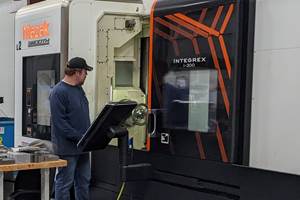Buying a Lathe: Spindles and Tailstocks
A key consideration when buying a new turning machine involves its spindle. Here’s an overview of what you need to know.
Share





After considering what sorts of workpieces your turning machine will need to handle, and taking a good look at tooling options, it’s a good time to cover what kinds of spindles lathes might have, and what factors are good to keep in mind when choosing a new machine.
Belt-Driven or Direct-Drive Spindles
The spindle on a turning center is either belt-driven or direct-drive. Generally, belt-driven spindles represent older technology. They speed up and slow down at a lower rate than direct-drive spindles, which means cycle times can be longer. If you’re turning small-diameter parts, the time it takes to ramp the spindle from 0 to 6,000 rpm is significant. In fact, it might take twice as long to reach this speed than with a direct-drive spindle.
A small degree of positional inaccuracy may occur with belt-driven spindles, because the belt between the drive and the positional encoders creates a lag. With integral direct-drive spindles, this is not the case. Ramping up and down with a direct drive-spindle happens at a high rate, and the positional accuracy also is high, a significant benefit when using C-axis travel on live-tooling machines.
A2 Spindle Noses
Lathes are designed to have an American Standard spindle nose on the front of the spindle motor. Tapered spindle noses come in various sizes to hold the chuck or threaded spindle mount. A2 and B2 are both short-taper spindles; the only difference between them is the method in which the chuck is mounted. Type L refers to long-taper spindles, and Type D features a camlock mounting used on many engine-lathe spindles.
The good news is, your machine tool manufacturer has the spindle nose selection worked out based on the size of the chuck, diameter of barstock you intend to machine and the horsepower needed. The spindle nose will be properly sized for the machine.
Spindle Speeds, Horsepower and Torque
Today’s CNC lathes are designed for specific ranges of stock diameters. Basically, you buy a machine to cut a specific, maximum workpiece diameter. If you’re cutting 2-inch-diameter barstock, the machine will be designed for running small diameters using higher-speed, 6,000-rpm spindles, and with the right amount of horsepower and torque.
Generally, big lathes have high torque (twisting power) due to the weight of the mass spinning in the chuck. As a rule, the bigger the workpiece and the slower the spindle speed, the more torque required.
If the parts you are running require a machine with a 10-inch, big-bore chuck, the spindle will be designed to deliver slower speeds at more horsepower. This creates the torque to take bigger cuts for more stock removal. As the cutter gets closer to the center of the stock, the machine will automatically speed up to, say, 700 rpm to maintain the proper surface footage. Obviously, it doesn’t make sense to use a big-bore lathe to do small-diameter work.
The operation that typically requires peak horsepower is heavy-duty, inner-diameter work, such as using big drills to make holes in the barstock before finish-boring. In this case, Z-axis horsepower might be the limiting factor. For example, a 2-inch drill may require a 20-hp spindle motor to get the force needed to perform this operation.
Programmable Tailstocks
A built-in, numerically controlled tailstock can be a valuable feature for automated processes. A fully programmable tailstock provides more rigidity and thermal stability. However, the tailstock casting adds weight to the machine.
There are two basic types of programmable tailstocks—servo-driven and hydraulic. Servo-driven tailstocks are convenient, but the weight they can hold may be limited. Typically, a hydraulic tailstock has a retractable quill with a 6-inch stroke. The quill also can be extended to support a heavy workpiece, and do so with more force than a servo-driven tailstock can apply. This is an advantage if you’re machining a piece that weighs, let’s say, 2,000 pounds. Using the programmable tailstock to push the part helps support its weight in the chuck.
This is part three of a four-part series about buying turning machines.
- Part one: Buying a Lathe: The Basics
- Part two: Buying a Lathe: Turrets and Live Tooling
Find more insights about acquiring a new machining center by visiting the Techspex Knowledge Center, “.”
Related Content
The Future of High Feed Milling in Modern Manufacturing
Achieve higher metal removal rates and enhanced predictability with ISCAR’s advanced high-feed milling tools — optimized for today’s competitive global market.
Read MoreOrthopedic Event Discusses Manufacturing Strategies
At the seminar, representatives from multiple companies discussed strategies for making orthopedic devices accurately and efficiently.
Read More4 Commonly Misapplied CNC Features
Misapplication of these important CNC features will result in wasted time, wasted or duplicated effort and/or wasted material.
Read More5 Tips for Running a Profitable Aerospace Shop
Aerospace machining is a demanding and competitive sector of manufacturing, but this shop demonstrates five ways to find aerospace success.
Read MoreRead Next
Machine Shop MBA
Making Chips and 91ÊÓƵÍøÕ¾ÎÛ are teaming up for a new podcast series called Machine Shop MBA—designed to help manufacturers measure their success against the industry’s best. Through the lens of the Top Shops benchmarking program, the series explores the KPIs that set high-performing shops apart, from machine utilization and first-pass yield to employee engagement and revenue per employee.
Read MoreAMRs Are Moving Into Manufacturing: 4 Considerations for Implementation
AMRs can provide a flexible, easy-to-use automation platform so long as manufacturers choose a suitable task and prepare their facilities.
Read MoreLast Chance! 2025 Top Shops Benchmarking Survey Still Open Through April 30
Don’t miss out! 91ÊÓƵÍøÕ¾ÎÛ's Top Shops Benchmarking Survey is still open — but not for long. This is your last chance to a receive free, customized benchmarking report that includes actionable feedback across several shopfloor and business metrics.
Read More





















